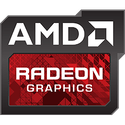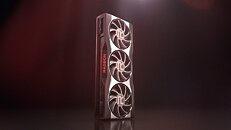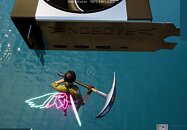Tuesday, September 15th 2020

AMD Radeon RX 6000 "Big Navi" RDNA2 Reference Design Pictured
AMD revealed its Radeon RX 6000 series graphics card reference design. This card will likely be AMD's flagship product based on its RDNA2 graphics architecture. The card features a refreshing new dual-slot, triple axial fan cooling solution that uses large new high-airflow fans that have webbed impellers, and an aluminium fin-stack heatsink that spans the entire length of this roughly-30 cm long card. A variation of the insert with the Radeon branding was teased last year. This is AMD's second reference design with triple axial fans, after the Radeon VII.
The card features two 8-pin PCIe power inputs right where you expect them. Display outputs include a pair of DisplayPorts, an HDMI, and a USB type-C. Since air exhaust is guided out of the top of the card with its fin-stack arrangement (and none from the rear I/O), AMD has a sealed I/O shield like the Radeon Fury. AMD partnered with Epic Games for a Fortnite treasure-hunt map that lets you see a 3D model of the card in from more angles. We'll spare you the treasure hunt with a video by Anshel Sag.The Fortnite video follows.
The USB-C connector got us thinking AMD's rationale behind it. VirtualLink is dead in the water, with almost no takers from the VR HMD segment. When this card was in development, AMD would have seen clear signs of VirtualLink's lukewarm market response. On the other hand, there are plenty of USB-C Thunderbolt-compatible professional monitors. It makes us wonder if AMD just strapped on an Intel "Cactus Ridge" controller and gave this card Thunderbolt capability, with DisplayPort passthrough? A grand-unified type-C port would be that which has DisplayPort, Thunderbolt, and USB3/USB4 connectivity.
Sources:
AMD Radeon RX (Twitter), via VideoCardz
The card features two 8-pin PCIe power inputs right where you expect them. Display outputs include a pair of DisplayPorts, an HDMI, and a USB type-C. Since air exhaust is guided out of the top of the card with its fin-stack arrangement (and none from the rear I/O), AMD has a sealed I/O shield like the Radeon Fury. AMD partnered with Epic Games for a Fortnite treasure-hunt map that lets you see a 3D model of the card in from more angles. We'll spare you the treasure hunt with a video by Anshel Sag.The Fortnite video follows.
The USB-C connector got us thinking AMD's rationale behind it. VirtualLink is dead in the water, with almost no takers from the VR HMD segment. When this card was in development, AMD would have seen clear signs of VirtualLink's lukewarm market response. On the other hand, there are plenty of USB-C Thunderbolt-compatible professional monitors. It makes us wonder if AMD just strapped on an Intel "Cactus Ridge" controller and gave this card Thunderbolt capability, with DisplayPort passthrough? A grand-unified type-C port would be that which has DisplayPort, Thunderbolt, and USB3/USB4 connectivity.





76 Comments on AMD Radeon RX 6000 "Big Navi" RDNA2 Reference Design Pictured
Nvidia tried it last Gen on the RTX cards Virtuallink alternative
That's so cliché...
On a serious note, while the card looks tolerable, it kinda looks like a typical AIB card from second tier companies. Not classy at all. Though as long as the cooler does it job well it doesn't matter I guess.
If AMD offers 3070 performance for 3070 money while having more VRAM I would buy it.
Just funny to see NVIDIA give up on it and in the same launch window AMD starts using it.
Nvidia already removed it from 20 series Super lineup.
On a side note, I am very excited to find out the truth about Ampere tomorrow. This engineer guy gives a great breakdown on why he thinks Nvidia have been very dishonest, so we're in for a little shock when these are reviewed:
Hint: the performance per watt improvement looks to be tiny, and RT performance increase is apparently very small, hence why Nvidia asked DF to bench Battlefield 2 with RT on.
Looks like something from a decade ago tbh.
The percentual performance hit on some games is bigger than the last generation, it's just that, given that the rasterized performance is much higher, the resulting framerate is still much better.
I myself would've bought a Ryzen CPU too if the 3000 series was available at the time.
No blower - check
3 air pressure fans - check
no blocked sides like in VII - check
fk me, is it truly looking like a reference card from AMD with cooler that does not suck?
Why 2x 8pin though? Can we get a card with good performance with just 1x 8pin like GTX 1000 series??
Strange.